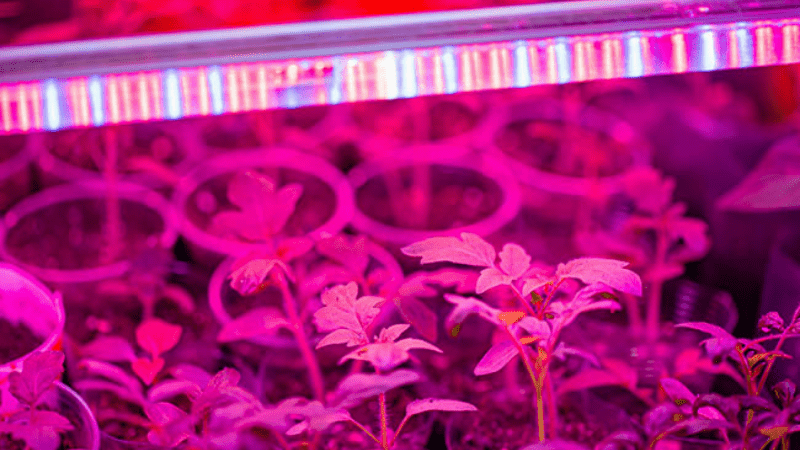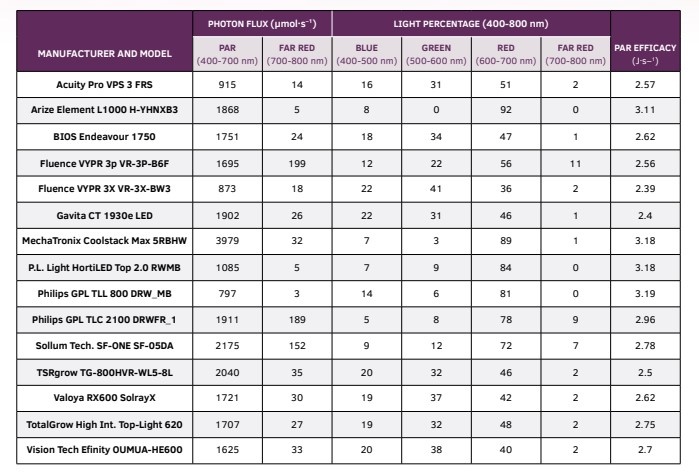
Technically Speaking: A 2024 LED lighting update
Light-emitting diodes (LEDs) have become the “go to” fixture type for most horticultural lighting applications. Growers are replacing high-pressure sodium (HPS) with LEDs, often delivering a higher intensity than before. In addition, new supplemental lighting installations are usually with LEDs.
There are several reasons for the widespread adoption of LEDs, most notably the technological advances and increased grower appreciation for how lighting can improve crop quality, decrease production time, or both. LEDs are much more complex than conventional fixtures because they vary widely in light output (intensity and spectrum), efficacy (electrical efficiency), beam angle, cost, ease of installation, etc.
Before delving into some performance characteristics of LEDs, we need to ensure that fixtures have been designed to tolerate growing conditions (for example, high humidity) and meet benchmark standards specific to horticulture. To help accomplish this, growers are advised to consider LED products that are on the Horticultural Lighting Qualified Product list by the DesignLights Consortium (DLC). Visit designlights.org for more information.
Three of the major ways to characterize an LED fixture are light output, light spectrum and efficacy. All three are based on photons within the photosynthetically active waveband (PAR; 400-700 nm). There are compelling reasons to also consider far-red light, which extends PAR (ePAR) to 750 or 800 nm.
Light output refers to the number of photons (in micromoles, or µmol) emitted by a fixture per second(s) and has a unit of µmol·s–1. Technically speaking, light output is the photon flux of the PAR (or ePAR) waveband, which can only be measured in a testing laboratory. The light spectrum refers to relative percentages of blue, green, red and far-red light, and although the peak wavelengths are also important, they are usually not reported.
Finally, fixture efficacy refers to the photon flux of a fixture divided by the energy consumed to emit that quantity of light. Its unit is micromoles per joule, or µmol·J–1. Fixture efficacy is usually reported for the PAR waveband (photosynthetic photon efficacy, or PPE).
Table 1 illustrates the variation in light output (photon flux), light spectrum (percentage of photons in each of four wavebands), and efficiency (efficacy) of 15 LED fixtures on the DLC Horticultural Lighting Qualified Products List. PAR refers to the photosynthetically active radiation waveband characteristics of 15 LED products qualified for horticultural use by the DLC. In early 2020, there were fewer than 100 qualified LED products for horticulture. In early 2024, there were around 1,500. By design, DLC-qualified products are at least 35% more efficient than HPS. For example, 440-W HPS lamps with a magnetic ballast have an efficacy of 0.94 µmol·J–1 and 1040-W double-ended HPS lamps with an electronic ballast have an efficacy of 1.70 µmol·J–1 based on data from Utah State University.

The vast majority of horticultural LED products consist of individual blue, white and/or red LEDs. Fixtures with the highest efficacies usually emit mostly red light, since red LEDs are the most efficient. The green light percentage is related to the percentage of white LEDs, and the light emitted will appear whiter as the percentage of green light increases. A low green light percentage (e.g., <15%) translates into light that will appear more pink or purple.
There is a large variation in photon flux among LED products, which means the fixture number, installation height and spacing and light uniformity can vary dramatically. In addition, some LED fixtures (including three in Table 1) emit a meaningful amount of far red light, which can directly and indirectly increase plant growth. However, these photons are not counted in the PAR photon flux measurements or efficacy metrics.
While the performance metrics of LEDs are important, there are other aspects that merit consideration when selecting a lighting fixture. This includes, but is not limited to, product/brand reliability, customer service, installation cost, electric rates, availability of energy rebates, fixture form factor and ease of installation.


 Video Library
Video Library 




















